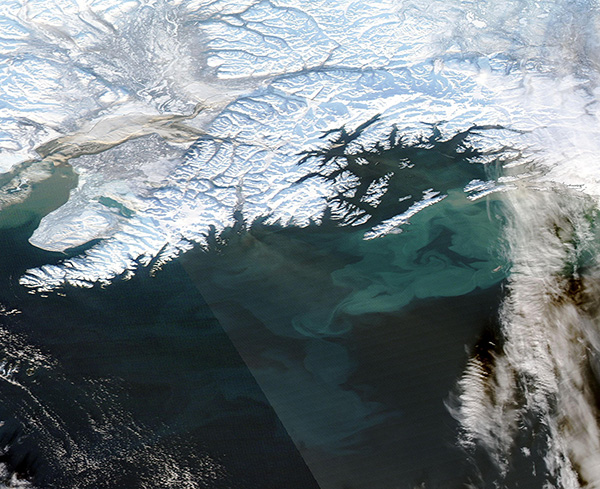Images
December 31, 2023 - Bloom in Gulf of Alaska
Tweet
Swirls of turquoise and tan sediment floating in the Gulf of Alaska leant color to the otherwise winter-white scene in late December 2023. The Moderate Resolution Imaging Spectroradiometer (MODIS) on NASA’s Aqua satellite acquired this true-color image on December 28.
In the west, suspended sediment turns the waters of the Cook Inlet tan and green. Sediment also tints the edges of ice covering the inlet, making them look muddy brown. South and east of the Kenai Peninsula, swirls of color fill the Gulf of Alaska. The dullness of the greens and tans close to the snow-laden shoreline are suggestive of sediment. It is also quite likely that phytoplankton—microscopic plant-like organisms—contribute to the color further away from shore.
The sediment common in this part of Alaska is called “glacial flour” or “rock flour”, and it is bedrock that has been ground into fine dust by the action of glaciers. When suspended in water, glacial flour not only can appear an opaque turquoise color, similar to some phytoplankton blooms, but it also carries nutrients that can spur the growth of phytoplankton.
Phytoplankton lives in these waters year-round in small numbers. When there is adequate nutrition, correct water temperatures, and enough daylight, they can reproduce explosively to create massive floating blooms that are easily seen from space.
Image Facts
Satellite:
Aqua
Date Acquired: 12/28/2023
Resolutions:
1km (296.5 KB), 500m (675.9 KB), 250m (994 KB)
Bands Used: 1,4,3
Image Credit:
MODIS Land Rapid Response Team, NASA GSFC
Tweet
Swirls of turquoise and tan sediment floating in the Gulf of Alaska leant color to the otherwise winter-white scene in late December 2023. The Moderate Resolution Imaging Spectroradiometer (MODIS) on NASA’s Aqua satellite acquired this true-color image on December 28.
In the west, suspended sediment turns the waters of the Cook Inlet tan and green. Sediment also tints the edges of ice covering the inlet, making them look muddy brown. South and east of the Kenai Peninsula, swirls of color fill the Gulf of Alaska. The dullness of the greens and tans close to the snow-laden shoreline are suggestive of sediment. It is also quite likely that phytoplankton—microscopic plant-like organisms—contribute to the color further away from shore.
The sediment common in this part of Alaska is called “glacial flour” or “rock flour”, and it is bedrock that has been ground into fine dust by the action of glaciers. When suspended in water, glacial flour not only can appear an opaque turquoise color, similar to some phytoplankton blooms, but it also carries nutrients that can spur the growth of phytoplankton.
Phytoplankton lives in these waters year-round in small numbers. When there is adequate nutrition, correct water temperatures, and enough daylight, they can reproduce explosively to create massive floating blooms that are easily seen from space.
Image Facts
Satellite:
Aqua
Date Acquired: 12/28/2023
Resolutions:
1km (296.5 KB), 500m (675.9 KB), 250m (994 KB)
Bands Used: 1,4,3
Image Credit:
MODIS Land Rapid Response Team, NASA GSFC




